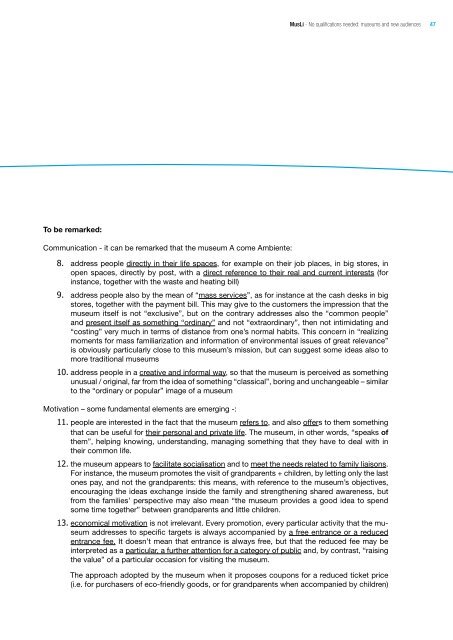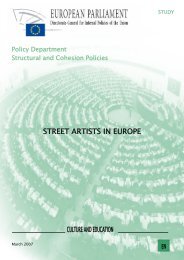MusLi (Museums Literacy) - Fondazione Fitzcarraldo
MusLi (Museums Literacy) - Fondazione Fitzcarraldo
MusLi (Museums Literacy) - Fondazione Fitzcarraldo
Create successful ePaper yourself
Turn your PDF publications into a flip-book with our unique Google optimized e-Paper software.
To be remarked:<br />
<strong>MusLi</strong> - No qualifications needed: museums and new audiences<br />
Communication - it can be remarked that the museum A come Ambiente:<br />
8. address people directly in their life spaces, for example on their job places, in big stores, in<br />
open spaces, directly by post, with a direct reference to their real and current interests (for<br />
instance, together with the waste and heating bill)<br />
9. address people also by the mean of “ mass services”, as for instance at the cash desks in big<br />
stores, together with the payment bill. This may give to the customers the impression that the<br />
museum itself is not “exclusive”, but on the contrary addresses also the “common people”<br />
and present itself as something “ordinary” and not “extraordinary”, then not intimidating and<br />
“costing” very much in terms of distance from one’s normal habits. This concern in “realizing<br />
moments for mass familiarization and information of environmental issues of great relevance”<br />
is obviously particularly close to this museum’s mission, but can suggest some ideas also to<br />
more traditional museums<br />
10. address people in a creative and informal way, so that the museum is perceived as something<br />
unusual / original, far from the idea of something “classical”, boring and unchangeable – similar<br />
to the “ordinary or popular” image of a museum<br />
Motivation – some fundamental elements are emerging -:<br />
11. people are interested in the fact that the museum refers to, and also offers to them something<br />
that can be useful for their personal and private life. The museum, in other words, “speaks of<br />
them”, helping knowing, understanding, managing something that they have to deal with in<br />
their common life.<br />
12. the museum appears to facilitate socialisation and to meet the needs related to family liaisons.<br />
For instance, the museum promotes the visit of grandparents + children, by letting only the last<br />
ones pay, and not the grandparents: this means, with reference to the museum’s objectives,<br />
encouraging the ideas exchange inside the family and strengthening shared awareness, but<br />
from the families’ perspective may also mean “the museum provides a good idea to spend<br />
some time together” between grandparents and little children.<br />
13. economical motivation is not irrelevant. Every promotion, every particular activity that the museum<br />
addresses to specific targets is always accompanied by a free entrance or a reduced<br />
entrance fee. It doesn’t mean that entrance is always free, but that the reduced fee may be<br />
interpreted as a particular, a further attention for a category of public and, by contrast, “raising<br />
the value” of a particular occasion for visiting the museum.<br />
The approach adopted by the museum when it proposes coupons for a reduced ticket price<br />
(i.e. for purchasers of eco-friendly goods, or for grandparents when accompanied by children)<br />
47






